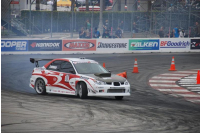We use cookies to make your experience better. To comply with the new e-Privacy directive, we need to ask for your consent to set the cookies. Learn more.
What is "Oversteer"?

Let’s say that you are driving on an icy street. You are going straight, but there is a corner coming up, so you turn your steering wheel. You turn it as you would normally, but all of a sudden, the rear of your car starts to rotate.
This is called Oversteer.
Basicaly, the term Oversteer means that you need to give your car less steering than the corner should require to get it to go around. Tending toward Oversteer will make you car will feel pretty nimble cornering, but it also can make the car difficult to control.
For a more scientific definition, imagine that we draw a tangent line to the circle that the car is going traveling around. If you don’t have to turn the wheels so that they are parallel to the tangent line, yet the car still travels around the circle, your car tends toward Oversteer.
Here’s another way to think of Oversteer. If you are driving around in a circle of constant radius, and you start accelerating, your rear tires will be the first to lose traction. This will cause the rear of your car to step out (which would require a counter-steering input), and will actually push the front of the car toward the center and reduce the radius of the circle.
There aren’t many cars on the market that will naturally tend to Oversteer. This is because it is much easier to lose control of an Oversteering car if the driver doesn’t respond with the correct steering input.
It should also be mentioned that there are a lot of variables in play when it comes to a car’s handing, and even if you have a car that tends to Oversteer, it may not do so in all cornering situations. One of the more significant variables is weight transfer from either acceleration or braking, and it will be discussed in another FAQ.

